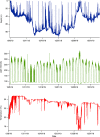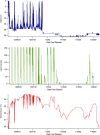Variable post-release mortality in common shark species captured in Texas shore-based recreational fisheries
- PMID: 36780489
- PMCID: PMC9925081
- DOI: 10.1371/journal.pone.0281441
Variable post-release mortality in common shark species captured in Texas shore-based recreational fisheries
Abstract
The practice of catch and release fishing is common among anglers but has been shown to cause unintended mortalities in some species. Current post-release mortality estimates used in coastal shark stock assessments are typically derived from boat-based shark fisheries, which differ from shore-based operations that expose sharks to potentially more stressful environmental and handling conditions. Recreational post-release mortality rates in shore-based fisheries must be quantified to improve stock assessment models and to create guidelines that protect species from overexploitation. Here, we partnered with experienced anglers acting as citizen scientists to deploy pop-up satellite archival transmitting tags (PSAT, n = 22) and acceleration data loggers (ADLs, n = 22). on four commonly caught sharks including the blacktip shark (Carcharhinus limbatus, n = 11), bull shark (Carcharhinus leucas, n = 14), tiger shark (Galeocerdo cuvier, n = 6), and great hammerheads (Sphyrna mokarran, n = 2). Mortality occurred within minutes to hours post-release. If evidence of mortality occurred after normal diving behavior had been re-established for 10 days, then the mortality was considered natural and not related to the catch-and-release process. Post-release mortality estimates ranged from 0% for bull and tiger sharks to 45.5% for blacktip sharks. Of the two great hammerheads, one died within 30 minutes post-release while the other exhibited mortality characteristics 14 days after release. Moribund blacktip sharks experienced on average 3.4-4.9°C warmer water compared with survivors. Recovery periods were estimated for survivors of each species and were highly variable, differing based on duration of tag deployment. High variability in responses to capture and release between species demonstrates the need for species-specific assessments of post-release mortality in shore-based recreational fisheries.
Copyright: © 2023 Binstock et al. This is an open access article distributed under the terms of the Creative Commons Attribution License, which permits unrestricted use, distribution, and reproduction in any medium, provided the original author and source are credited.
Conflict of interest statement
The authors have declared that no competing interests exist.
Figures






References
-
- Babcock EA. Recreational fishing for pelagic sharks worldwide. Sharks of the open ocean: biology, fisheries and conservation. 2008; 193–204.
-
- McPhee DP, Leadbitter D, Skilleter GA. Swallowing the bait: is recreational fishing in Australia ecologically sustainable? Pacific conservation biology. 2002;8: 40–51.
-
- Post JR, Sullivan M, Cox S, Lester NP, Walters CJ, Parkinson EA, et al.. Canada’s recreational fisheries: the invisible collapse? Fisheries (Bethesda). 2002;27: 6–17.
-
- Muoneke MI, Childress WM. Hooking mortality: A review for recreational fisheries. Reviews in Fisheries Science. 1994;2: 123–156. doi: 10.1080/10641269409388555 - DOI
-
- Bartholomew A, Bohnsack JA. A review of catch-and-release angling mortality with implications for no-take reserves. Rev Fish Biol Fish. 2005;15: 129–154.
Publication types
MeSH terms
Supplementary concepts
LinkOut - more resources
Full Text Sources
Research Materials

